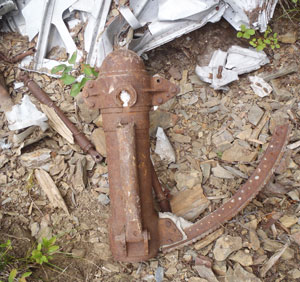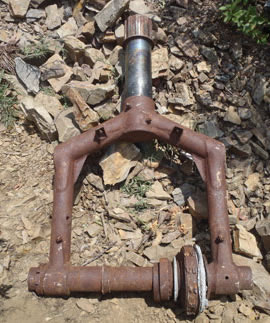 |
Earhart Project Research Bulletin#69
September 10, 2013
Bevington Object Update |
TIGHAR’s best single piece of evidence just got better.
The strength of the Nikumaroro Hypothesis is that so many unrelated avenues of investigation — archival records, artifacts, historical photographs, analyses of radio signals and tidal conditions, etc. — all point to the same conclusion. Of course, some types of evidence are stronger than others. Anecdotal recollections, often known as “oral history” or “eyewitness testimony,” are the least reliable form of evidence due to the fallibility of human perception and memory. At the other end of the credibility spectrum are objects and data that can be measured or otherwise quantified.
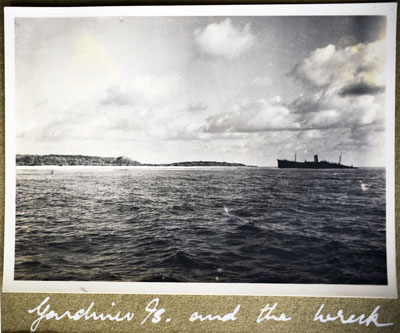 TIGHAR’s best piece of quantifiable evidence suggesting that the Earhart/Noonan flight ended at Gardner Island (now Nikumaroro) was discovered in 2010 by forensic imaging specialist Jeff Glickman in a photograph taken three months after the flight’s disappearance by British Colonial Service officer Eric R. Bevington.
TIGHAR’s best piece of quantifiable evidence suggesting that the Earhart/Noonan flight ended at Gardner Island (now Nikumaroro) was discovered in 2010 by forensic imaging specialist Jeff Glickman in a photograph taken three months after the flight’s disappearance by British Colonial Service officer Eric R. Bevington.
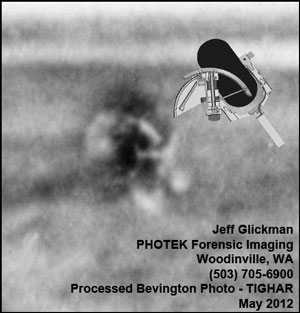 An object protruding from the water on the island’s western reef, although unnoticed or dismissed as unimportant by the photographer, appears to be the mangled remains of Lockheed Installation 40650 – one of the main landing gear assemblies of a Lockheed Electra. It was in large part the strength of this interpretation of the image, corroborated by U.S. Government photo analysts, that prompted then-Secretary of State Hillary Rodham Clinton to endorse TIGHAR’s Niku VII expedition at a special State Department event on March 20, 2012. (For the full story of TIGHAR’s investigation of the Bevington Object see “The Object Formerly Known as Nessie” in the March 2013 issue of TIGHAR Tracks.)
An object protruding from the water on the island’s western reef, although unnoticed or dismissed as unimportant by the photographer, appears to be the mangled remains of Lockheed Installation 40650 – one of the main landing gear assemblies of a Lockheed Electra. It was in large part the strength of this interpretation of the image, corroborated by U.S. Government photo analysts, that prompted then-Secretary of State Hillary Rodham Clinton to endorse TIGHAR’s Niku VII expedition at a special State Department event on March 20, 2012. (For the full story of TIGHAR’s investigation of the Bevington Object see “The Object Formerly Known as Nessie” in the March 2013 issue of TIGHAR Tracks.)
The match between what we could see in the photo and the best information we had about the Electra’s landing gear was good but not perfect. Were the discrepancies in the photo or in the drawings we were comparing it to?
Electra c/n 1011 at the Pima Air Museum. Some of the components in Installation 40650 are difficult to see when the assembly is installed on an aircraft.
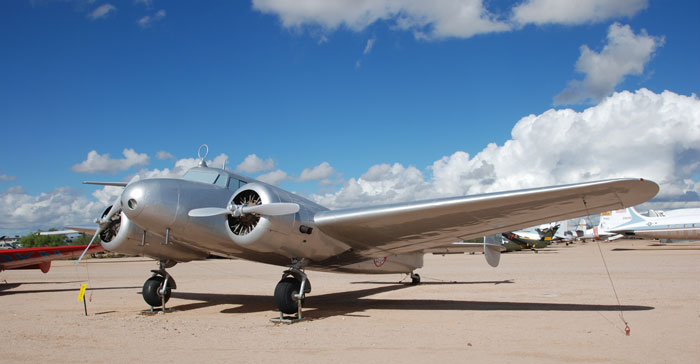
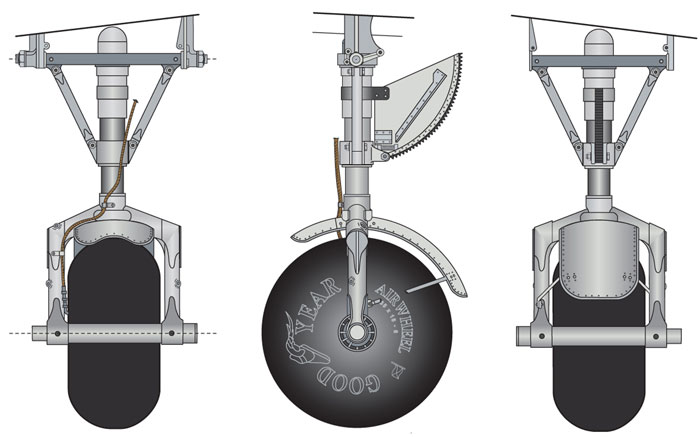
Lacking a complete set of Lockheed engineering drawings for the Model 10, our best sources were the detailed sketches of the landing gear made by Bill Harney for the construction of his meticulous model of the Earhart Electra.
TIGHAR’s 2013 Aviation Archaeology Field School provided an unexpected and fortunate opportunity to get better information about the shape of Electra landing gear components. The focus of the school was Lockheed Electra c/n 1024 delivered to Northwest Airlines in May 1935. In the early morning hours of December 18, 1936 while en route from Missoula, Montana to Spokane, Washington carrying mail but no passengers, the aircraft hit the face of a mountain ten miles southeast of Kellogg, Idaho. Today most of the aircraft’s aluminum is gone, either consumed in the post-crash fire or salvaged later, but many of the heavy steel structures are present, including both main landing gear assemblies. The Northwest Airlines Electra had landing gear identical to Earhart’s aircraft and, just as in the Luke Field accident, one main gear assembly remained intact and the other came apart.
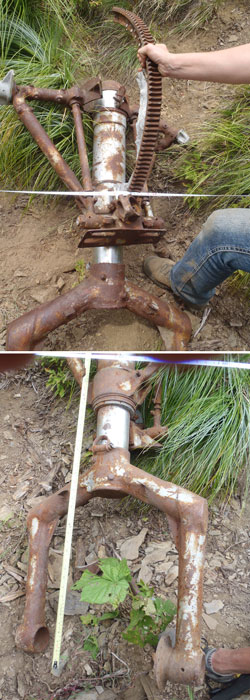 The oleo strut of the right main landing gear assembly remained intact. The axle, tire and wheel are gone. |
The shaft of the oleo strut of the left main gear extracted from the sleeve undamaged. The axle and brake are present but the tire and wheel are gone. |
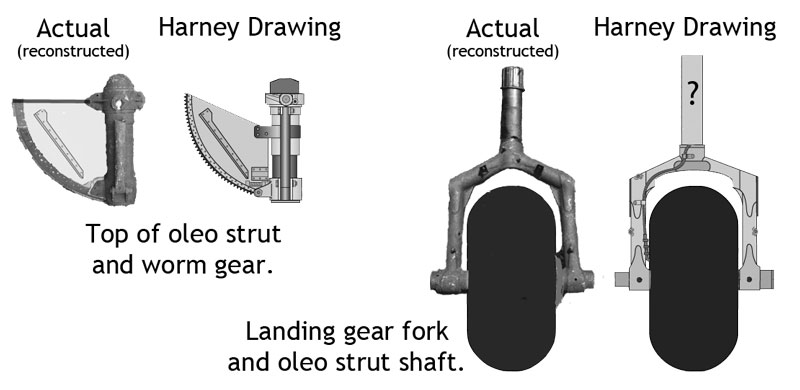
The wreckage allowed us to correct the shapes of the landing gear components shown in the Harney Drawings and permitted a more accurate comparison to the shapes seen in the Bevington Object.
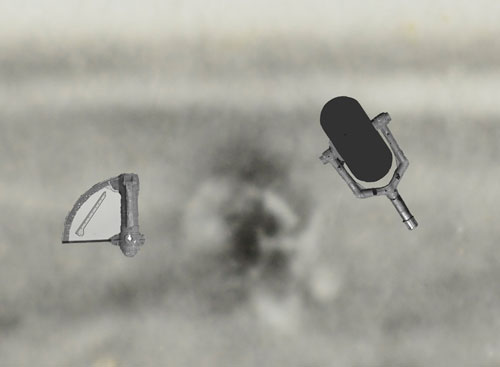
The length of the complete oleo strut shaft (Lockheed Part No. 40676) and the enlarged cuff on the end of the shaft match the Bevington Object.
The shape of the top of the landing gear fork (Lockheed Part No. 40776) is more pointed than shown in the Harney Drawings and is a good match to the shape in the Bevington Object. After 77 years, the Idaho fork is rust-colored but after only three months the fork would likely still be light-colored as seen in the Bevington Object.
The correct shape of the worm gear (Lockheed Part No. 41065) is a better match to the shape in the Bevington Object than the incorrect shape in the Harney Drawings. In the Idaho wreck, the aluminum portion of the component has been consumed by the post-crash fire leaving only the steel gear. In the Bevington Object the light-colored aluminum and the dark steel gear along the edge are visible.
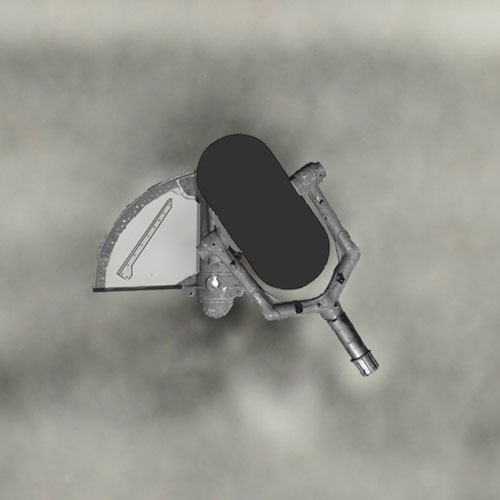
Reconstructions based on photos of actual Electra landing gear components are a much better fit and present a logical explanation for the jumble of shapes in the Bevington Object.
The Bevington Object is the right size and is, to an amazingly precise degree, the right shape to be the wreckage of one of the landing gear from Earhart’s Electra, left behind as the aircraft was washed over the edge of the reef. An artifact is identified by finding a known thing that is exactly like the unknown thing. The Bevington Object, however, is not a thing. Rather, it is an image of a thing and images can be deceiving. Compelling as it may appear, the Bevington Object is not proof that NR16020 was there. Confirmation that the Earhart/Noonan flight ended on Nikumaroro must await the identification of a physical object that can be conclusively linked to the Electra or its crew. That’s why we’re going back. Your continued support is vital.
